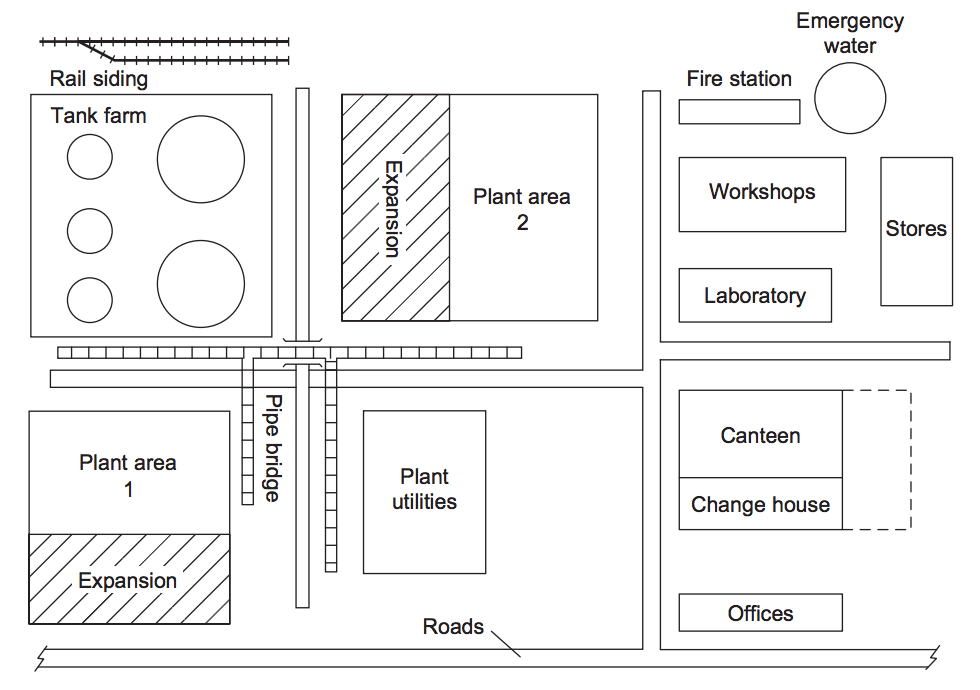Process location decisions
Author: Ellen Zhuang [2016]
Stewards: Daniel Garcia, and Fengqi You
Introduction
Location is one of the first decisions in the design of a new chemical plant. It impacts the profitability of the project and the scope for future expansion. If the project is a new facility, a suitable site must be found and an optimal layout of the site and process units must be planned. If the project adds to an existing site, the impact of the new addition on the existing plant must be considered. The plant also needs to accommodate for the nearby infrastructure, the services that it requires, and its environmental impacts.
Location Selection Factors
A plant's site is chosen based on several factors. These include:
1. Location with respect to market: If the plant produces high-volume and low-cost products, such as cement and fertilizer, it may be better to situate the plant closer to the primary market since transportation cost is a large fraction of the sales price. If the product is low-volume and high-cost, like pharmaceuticals, then the benefits of being closer to the primary market may not be there.
2. Raw material supply: The location also depends on the availability and price of raw material. Facilities that produce chemicals in bulk are usually located close to the source of raw material if the costs of shipping the product is less than the costs of shipping the feed. For example, ethylene production is growing in the Middle East since cheap ethane from natural gas is readily available. Oil refineries tend to be located near areas with high population since it is expensive to transport the oil.
3. Transport facilities: Facilities should be close to at least two major forms of transportation, whether that be road, rail, waterway, and/or seaport.
4. Availability of labor: Skilled workers are usually brought to the plant from outside the area. There should be a local pool of unskilled labor that can be trained to operate the plant, and of skilled craft workers to maintain the process units. Local labor laws, trade union customs, restrictive practices for recruitment and training should also be taken into consideration.
5. Availability of utilities: Processes that require a substantial amount of cooling water is usually located near water sources, such as rivers or wells. Those that need large quantities of power, such as electrochemical ones, are typically close to cheap power sources.
6. Availability of suitable land: The ideal land is flat, well-drained, with suitable load-bearing characteristics. Further considerations have to be made if the land is reclaimed land near the ocean in earthquake zones.
7. Environmental impact: Depending on the location, it may be more difficult and costly to dispose of wastes. During the project design phase, experts are typically consulted to learn more about an area's local regulations.
8. Local community considerations: The plant location should impost no additional risk to the local residents. For example, they should be downwind of the residential areas. Building a new plant can also create jobs in that area. Local communities also need to be able to accommodate the plant personnelles.
9. Climate: The climate of the area may affect costs. For example, plants in cold areas need more insulation and special heating. Facilities in earthquake areas need to be seismically sound.
10. Political and strategic considerations: Government sometimes gives capital grants, tax concessions, and other incentives to encourage plants to be built in specific areas. Companies can also globalize and take advantage of areas with preferential tariff agreements.
Site Layout
The process units and buildings need to be arranged in such a way that allows for the most economical flow of materials and people. Furthermore, dangerous processes need to be a safe distance from other buildings, and the layout should be planned to allow for future expansion.
Process units are usually laid out first in an arrangement that allows for smooth flow of materials between the process steps. The distance between equipment is usually at least 30 m. Next, the location of the principal ancillary buildings are sited as to minimize the time that it takes the workers to travel between buildings. Administrative offices and laboratories are located away from hazardous processes. Control rooms are next to the processing equipment. Utility buildings are located as to minimize piping between the process units. Storage is placed between the loading and unloading facilities and next to the process units that they serve. Tanks containing hazardous material are placed at least 70 m from the plant. An example of a typical site plan is shown below.
